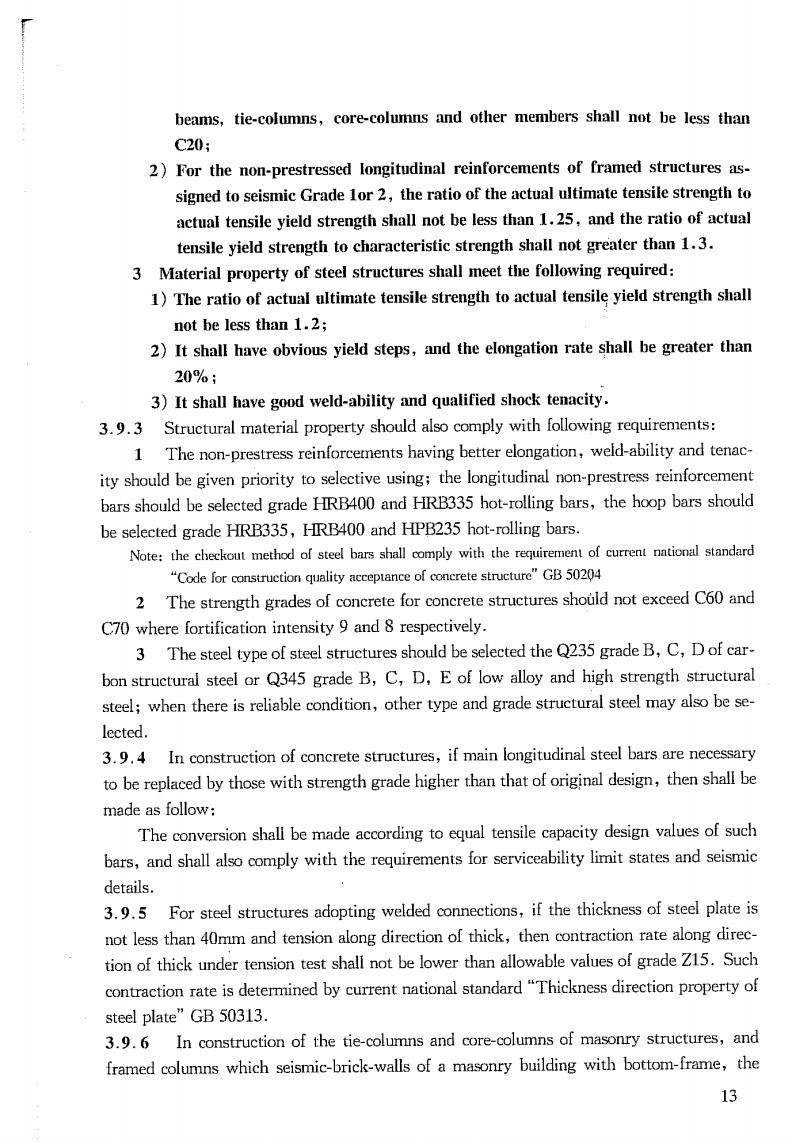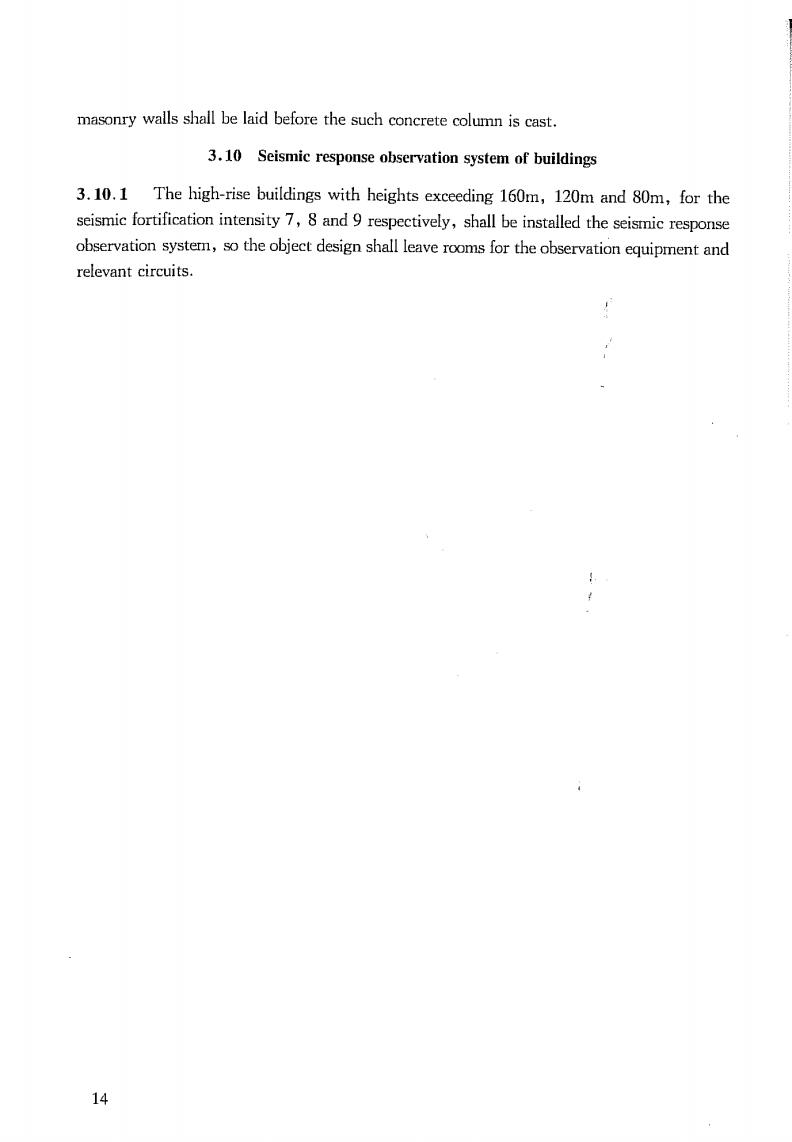
beams,tie-columns,core-columns and other members shall not be less than C20: 2)For the non-prestressed longitudinal reinforcements of framed structures as. signed to seismic Grade lor 2,the ratio of the actual ultimate tensile strength to actual tensile yield strength shall not be less than 1.25,and the ratio of actual tensile yield strength to characteristic strength shall not greater than 1.3. 3 Material property of steel structures shall meet the following required: 1)The ratio of actual ultimate tensile strength to actual tensile yield strength shall not be less than 1.2; 2)It shall have obvious yield steps,and the elongation rate shall be greater than 20%; 3)It shall have good weld-ability and qualified shock tenacity. 3.9.3 Structural material property should also comply with following requirements: 1 The non-prestress reinforcements having better elongation,weld-ability and tenac- ity should be given priority to selective using;the longitudinal non-prestress reinforcement bars should be selected grade HRB400 and HRB335 hot-rolling bars,the hoop bars should be selected grade HRB335,HRB400 and HPB235 hot-rolling bars. Note:the checkout methd of stee bars shal comply with the requiremen of curen nationl standard "Code fori qulityofsutureGB 50204 2 The strength grades of concrete for concrete structures should not exceed C60 and C70where fortification intensity9 and8 respectively. 3 The steel type of steel structures should be selected the Q235 grade B.C,Dof car- bon structural steel or Q345 grade B,C,D.Eof low alloy and high strength structural steel;when there is reliable condition,other type and grade structural steel may also be se- lected. 3.9.4 In construction of concrete structures,if main longitudinal steel bars are necessary to be replaced by those with strength grade higher than that of original design,then shall be made as follow: The conversion shall be made according to equal tensile capacity design values of such bars,and shall also comply with the requirements for serviceability limit states and seismic details. 3.9.5 For steel structures adopting welded connections,if the thickness of steel plate is not less than 40mm and tension along direction of thick,then contraction rate along direc- tion of thick under tension test shall not be lower than allowable values of grade Z15.Such contraction rate is determined by current national standard"Thickness direction property of steel plate”GB50313. 3.9.6 In construction of the tie-columns and core-columns of masonry structures,and framed columns which seismic-brick-walls of a masonry building with bottom-frame,the 13

masonry walls shall be laid before the such concrete column is cast. 3.10 Seismic response observation system of buildings 3.10.1 The high-rise buildings with heights exceeding 160m,120m and 80m,for the seismic fortification intensity 7,8 and 9respectively,shall be installed the seismic response observation system,so the object design shall leave rooms for the observation equipment and relevant circuits

Chapter 4 Site,Subsoil and Foundation 4.1 Site 4.1.1 When selecting a constructional place,the identification as favorable plat,unfavor- able plat or hazardous plat to seismic fortification shall be made according to Table 4.1.1. Table4.1.1 Identification of plat Plats Goolgicl,topogrphicnl and geomorphicl description Favorable to scismic Suble kfformifwhichre nawide open area. hidden ,ekitchndpit,wel otedwith xcvatcdandd) uduring thendherobecr 4.1.2 The site class of building structures shall be classified according to the equivalent shear-wave velocity of soil and thickness of site overlying layer as guideline 4.1.3 The measure of shear-wave velocity of soil shall comply with following require- ments: 1 At the stage of primary investigation,for large areas of same geologic units,the number of borings for the shear-wave-velocity tests shall be 1/3 to 1/5 of the controlled bor- ing numbers.For the mountain valleys or mountain slopes,such number may be reduced apropos but should not be less than 3. 2 At the stage of detailed investigation,for every building,the number of borings for shear-wave-velocity tests should not be less than 2;when the data varies significantly,the number can be increased apropos.In the case of close-set tall building groups in one sub- zone,which are built at the same geologic unit,such number may be reduced apropos but shall not be less than one for each tall building 3 For buildings assigned to Category D or to Category C with less than 10 stories and no more than 30m in height,when the shear-wave velocity data are not available,appropri- ate shear-wave velocity values are permitted to be estimated by used the known geologiccon ditions.In these cases,the type of soil may be classified according to Table 4.1.3 by the geotechnical description of the soil,and then the shear-wave velocity of each soil layer may be estimated within the range as per set in Table 4.1.3 based on the local experiences. 15

Table 4.1.3 Classification of soil and range of shear-wave velocity Shear-wave velocity of Type of soil Stiff s orok Medium-stiff soil um-dense gravel,coarse or medium sand,cohesive soil an 5002u.>250 silt withf>200kPa Medium-ot eoheieolan 2502,>140 i witha≤20okra,fill land withfa>130kP Muck and mucky soil,loose sand,new alluvial sedimen Soft soil 0,≤140 of cohesive soil and silt,fill land with 130kPa Note:is the reference vale of dberin capcity ofis the shear-wave vclocity. 4.1.4 The thickness of site overlaying layer shall be determined according to the follow- ing provisions: 1 In generally,the thickness of sife overlaying layer shall be determined according to the distance from the ground surface to a soil-layer level,under which the shear-wave veloci- ty is more than 500m/s. 2 For a soil layer,which depth lower than 5 m underground and'the shear-wave ve- locity is more than 2.5 times of that in above this soil layer and is not'less than 400m/s, then the thickness of site overlaying layer may be adopted the distance from the ground sur- face to this layer. 3 The lone-stone and lenticular-soil with a shear-wave velocity greater than 500m/s shall be deemed the same as surrounding soil profile. 4 The hard volcanic inter-bedded rock in the soil profile shall be deemed as rigid body and its thickness shall be deducted from the thickness of site overlaying layer 4.1.5 The equivalent shear-wave velocity of the soil profile shall be.calculated according to the following equation: ℃e=do/t (4.1.5-1) 1=2d) (4.1.5-2) where:vs -equivalent shear wave velocity,in m/s. do- -calculated depth,in m;it shall be taken as the minor of both the overlaying thickness and 20m. t -the transmission time of the shear-wave from the ground surface to the calcu lated depth. d -the thickness of the i-th soil layer within the range of calculated depth,in m 16

the shear-wave velocity of the i-th soil layer within the calculated depth,in 1m/s. -number of soil layers within the range of calculated depth 4.1.6 The construction sites shall be classified as four Site-classes defined in Table 4.1. 6 depend on the equivalent shear-wave velocity and the overlaying thickness of soil profile. Only the values of the reliable shear-wave velocity and/or the overlaying thickness are near to the dividing line of the listed site values in Table 4.1.6,the design characteristic period value shall be permitted to determined by the interpolation method in calculating the seis- mic action Table 4.1.6 Overlaying thickness of soil profile for site classification,in m Equivalent shear-wove Site-clasees velocity (m/s) 1 v.>500 0 500≥v>250 <5 ≥5 2502y>140 <3 3-50 >50 ≤140 3-15 >15-80 >80 4.1.7 When seismogenic faults exist within the site,the impact assessment on the project for the fault shall be made,which shall comply with the following requirements: 1 If one of the following conditions can be satisfied,the impact on the building struc- tures for the fault motion may be neglected: 1)For Intensity 6 and 7; 2)Not Holocene active faults; 3)For Intensity 8 and 9,the depth of overlaying soil for the hidden pre-Quaternary fault is greater than 60m and 90m respectively. 2 In the event that the situation does not conform to the provisions in item 1 of this clause,the main fault zone shall be avoided in the selection of site.The distance of avoid- ance should not be less than the minimum distance of avoidance in accordance with Table 4.1.7. Table 4.1.7 Minimum distance of avoidance for seismogenic fault A B C D 8 Specilication 300m 200m 9 500m 300m 4.1.8 When buildings assigned to Category C or A and B need to be constructed in unfa vorable plats,which are such as stripe-protruding spur,lonely tall hill,non-rocky steep slop,river banks or boundary of slopes,that shall conform to follows: 1>